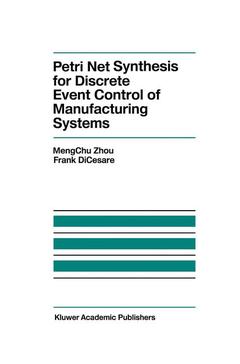Petri Net Synthesis for Discrete Event Control of Manufacturing Systems, Softcover reprint of the original 1st ed. 1993 The Springer International Series in Engineering and Computer Science Series, Vol. 204
Langue : Anglais
Auteurs : MengChu Zhou , Dicesare F.

Petri Net Synthesis for Discrete Event Control of ManufacturingSystems develops two essential resource-sharing concepts: parallel and sequential mutual exclusions and theoretical results in Petri synthesis. A parallel mutual exclusion (PME) is defined to model a resource shared by independent distributed processes, and a sequential mutual exclusion is a sequential composition of PMEs, modeling a resource shared by sequentially-related processes.
A hybrid synthesis methodology for Petri net models and controllers is proposed using top-down, modular, and bottom-up design ideas and the mutual exclusion theory. An aggregate Petri net model is refined by replacing places and /or transitions with basic design modules which are mathematically and graphically described. Petri net design methods are presented for such buffers as automatic storage and retrieval systems. Using the proposed method synthesizes both Petri net structure and feasible initial markings, guaranteeing that resulting Petri nets have desirable system properties such as freedom from deadlock and cyclic behavior.
A Petri net controller is extended to error recovery for automated manufacturing systems. The theory can guarantee that the desired system properties achieved by the original design will be preserved when the controller is augmented to deal with an error in the prescribed methods. Control code has been directly generated from Petri net definitions. The algorithm and implementation details are given for a flexible manufacturing system. Using the approach presented in Petri Net Synthesis for Discrete Event Control ofManufacturing Systems, engineers and research workers can develop their own discrete event control applications and experiments.
A hybrid synthesis methodology for Petri net models and controllers is proposed using top-down, modular, and bottom-up design ideas and the mutual exclusion theory. An aggregate Petri net model is refined by replacing places and /or transitions with basic design modules which are mathematically and graphically described. Petri net design methods are presented for such buffers as automatic storage and retrieval systems. Using the proposed method synthesizes both Petri net structure and feasible initial markings, guaranteeing that resulting Petri nets have desirable system properties such as freedom from deadlock and cyclic behavior.
A Petri net controller is extended to error recovery for automated manufacturing systems. The theory can guarantee that the desired system properties achieved by the original design will be preserved when the controller is augmented to deal with an error in the prescribed methods. Control code has been directly generated from Petri net definitions. The algorithm and implementation details are given for a flexible manufacturing system. Using the approach presented in Petri Net Synthesis for Discrete Event Control ofManufacturing Systems, engineers and research workers can develop their own discrete event control applications and experiments.
1 Introduction.- 1.1 Motivation.- 1.2 Modeling and Control of Discrete Event Systems.- 1.3 Objectives of This Book.- 2 Petri Nets and Manufacturing Systems.- 2.1 Petri Net Definitions and Properties.- 2.2 Modeling Manufacturing With Petri Nets.- 2.3 Summary.- 3 Parallel Mutual Exclusions.- 3.1 Introduction.- 3.2 Definition and Example.- 3.3 Development of Theoretical Results.- 3.4 Application Example.- 3.5 Generalized Parallel Mutual Exclusion.- 4 Sequential Mutual Exclusion.- 4.1 Introduction.- 4.2 Definition and Example.- 4.3 Token Capacity Concept.- 4.4 Parameters ?, ?, and ?.- 4.5 Development of Theoretical Results.- 4.6 Further Theoretical Extensions.- 4.7 Generalized Sequential Mutual Exclusions.- 4.8 Comparison With Previous Research.- 5 Hybrid Synthesis of Petri Nets.- 5.1 Introduction.- 5.2 Design of First-level Petri Net Models.- 5.3 Basic Design Modules.- 5.4 Petri Net Modeling of Buffers.- 5.5 Synthesis Procedure Description.- 6 Illustration of Hybrid Synthesis.- 6.1 An Automated Manufacturing System.- 6.2 Modeling Process.- 6.3 Discussion.- 7 Discrete Event Control of FMS.- 7.1 Introduction.- 7.2 The Flexible Manufacturing System.- 7.3 Design of a Petri Net for the FMS.- 7.4 Implementation of the Discrete Event Control.- 7.5 Summary.- 8 Augmentation of Petri Nets.- 8.1 Introduction.- 8.2 Design of Petri Net Controllers.- 8.3 Augmentation Methods of Petri Nets.- 8.4 An Application Example.- 8.5 Summary.- 9 Petri Nets: Past, Present and Future.- 9.1 Petri Net Theory Development.- 9.2 Applications in Manufacturing and Automation.- 9.3 Petri Net Design Methods for DES.- 9.4 Petri Nets in the Future.- Appendix A.
Date de parution : 10-2012
Ouvrage de 233 p.
15.5x23.5 cm
Mots-clés :
Transit; algorithms; control; design; manufacturing; model; modeling; system; tables
© 2024 LAVOISIER S.A.S.



